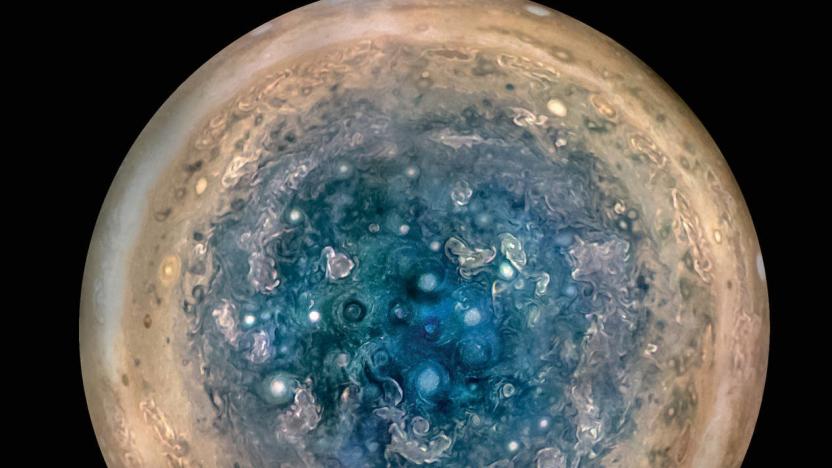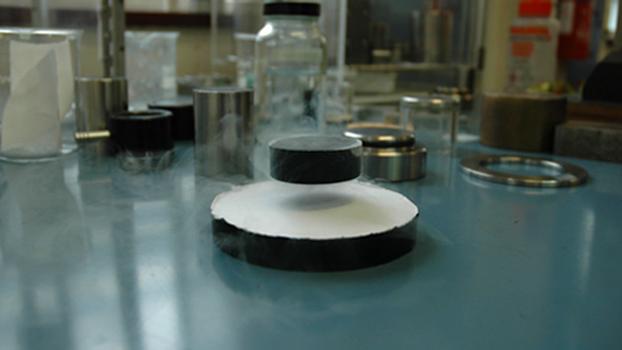MagneticFields
Latest

NASA’s Juno mission discovers Jupiter is really weird
NASA's Juno mission to Jupiter has sent back a ton of data about our solar system's largest planet. The results from the orbiter's first big data-collection pass, which took place last August, are finally in and it's clear that Juno's five-year journey to the planet was worth the trip.

Scientists control soft robots with magnetic fields
As slick as soft robots are, they tend to have very simple movements. It'd be a challenge to create a truly complex machine using existing technology. Researchers may have a solution to more sophisticated movement, though. They've invented a technique that uses magnetic fields to steer squishier robots. The trick was to cover the robots in a polymer film loaded with iron microparticles made to form parallel chains using a magnetic field. When you want to steer a robot, you just subject its relevant components to another magnetic field -- the direction and strength of the field determines what happens.

Yale's liquid metal material can shed light on magnetic fields
We most likely won't reach the center of the Earth in this lifetime, but scientists might be able to recreate it with the help of Yale's new liquid metal material. Researchers from the university have created a substance made of various particles suspended in indium and gallium (eGaIn) alloy. It flows just like the liquid metal that surrounds our planet's solid inner core, and it also generates magnetic fields when it does. Since its ability to generate magnetic fields is five times stronger than pure liquid metals', scientists can use it in the lab to study the cores of planets and stars.

Scientists confirm twisty fusion device's odd magnetic fields
Now that the first large version of a extraordinarily complex, cruller-shaped stellarator fusion device is up and running, there's an overriding question: is it behaving the way scientists expected? Thankfully, the answer is yes. Researchers have confirmed that Germany's Wendelstein 7-X stellarator is producing the 3D magnetic fields that were anticipated from its twisty design. In fact, it's faithful to the concept with "unprecedented accuracy" -- the error rate is less than one in 100,000.

New magnetic field theory gets us closer to nuclear fusion
Researchers from the US Department of Energy (DoE) and Princeton University have developed a new theory on plasma that could help scientists figure out solar flares and fusion power. Most fusion research is focused on "magnetic confinement" reactors that use powerful magnets to fuse hydrogen plasma into helium. One of the biggest problems with that technique is that the plasma itself spawns new magnetic fields, which play havoc with the reactions.

Bluetooth alternative sends signals through the human body
A team of researchers from the University of California, San Diego announced Tuesday that they had developed a proof-of-concept wireless transmission system that is both more efficient and more secure than Bluetooth. It works by sending data signals through your body's natural magnetic field instead of over the air and could lead to a new class of ultra-low power wearables.

Scientists create a 'wormhole' for magnetic fields
Humanity is still a long way from creating space-time wormholes -- if they're even possible -- but that isn't stopping Spanish researchers from achieving something similar for magnetism. They've produced a wormhole-like effect that transports a magnetic field from one point in space to another through an "invisible" path. The trick was to transmit magnetic fields between two spheres linked by a multi-layer, spiraling cylinder whose materials hide the fields while they're in transit. It's as if they vanished, and then popped back into existence somewhere else.

Magneto-Track smart footballs give officials their location and direction
Sure, football arenas like Levi's Stadium are being outfitted with everything modern technology has to offer, but what about the game itself? Don't worry, researchers are working on improving that too: engineers at Carnegie Mellon and NC State have developed a football tracking system that could one day replace the old "stick-and-chain" measurement system for calling a first down. It's called the Magneto-Track system, and it uses low-frequency magnetic fields to follow a tracker embedded in the game ball. The result? A real-time measurement of the ball's position and orientation on the field.

Record-breaking magnet crams three tons of force into the size of a golf ball
University of Cambridge scientists have broken a decade-old superconducting record by packing a 17.6 Tesla magnetic field into a golf ball-sized hunk of crystal -- equivalent to about three tons of force. The team used high-temperature superconductors that work at minus 320 degrees F or so -- not exactly balmy, but less frigid than the minus 460 degrees F needed for regular superconductors. With zero resistance, superconducting materials can carry up to 100 times more current than copper wires, but the resulting magnetic fields create huge internal forces. Since the cuprate materials used for the record are as fragile as dried pasta, they can actually explode under the strain. To get around it, the team modified the material's microstructure and "shrink-wrapped" it in stainless steel. That produced the largest magnetic field ever trapped in a standalone material at any temperature, according to the team. The research might eventually lead to more secure and efficient power transmission, better scanners and yes, levitating monorails. [Image credit: University of Cambridge]

New York planetarium to host 200-player space game tonight (video)
Got plans for this evening? Cancel them now, and do everything you can to sneak into New York's Museum of Natural History. Because tonight, the museum's planetarium will play host to a 200-person space game, courtesy of Brooklyn's Babycastles arcade. It's all part of the museum's "Cosmic Cocktails and Space Arcade" evening -- an event that seems tailor made for anyone interested in cosmology, humans, and/or hallucinogens. The showcase of the soiree is the Space Cruiser game, which promises to turn the ceiling of the Rose Center for Earth and Space into a "living, breathing, space ship where participants navigate around a beautiful fictitious universe." With the Magnetic Fields' Stephin Merritt assuming the tripartite role of ship captain-navigator-narrator, the game apparently begins with the birth of the universe, before transporting visitors across new galaxies and through time-bending wormholes. The ship launches at 6:30 PM tonight, but unfortunately, tickets are already sold out. Head past the break, though, for a rather "duuuude"-inducing video.

Robins can see magnetic fields with a keen right eye
When it's time to migrate, how do birds find north? The going theory is that some avians can literally see the magnetic fields. Talk about a birds-eye view. However, a recent experiment shows that ability is hampered unless the creature in question has good vision in the right eye. Outfitting a variety of European robins with goggles frosted on one side and clear on the other -- but transmitting the same amount of light to both eyes -- a team of researchers at Goethe-Universitat in Germany discovered that the birds with blurred vision in their right eye were disoriented, while those with obscured sight on the left headed north without delay. Since we mastered the compass ages ago, there are precious few lessons here for robotic bird builders -- but perhaps once these scientists are satisfied with ocular experiments, they'll get around to figuring out how carrier pigeons manage those cellphone-smuggling return flights.






